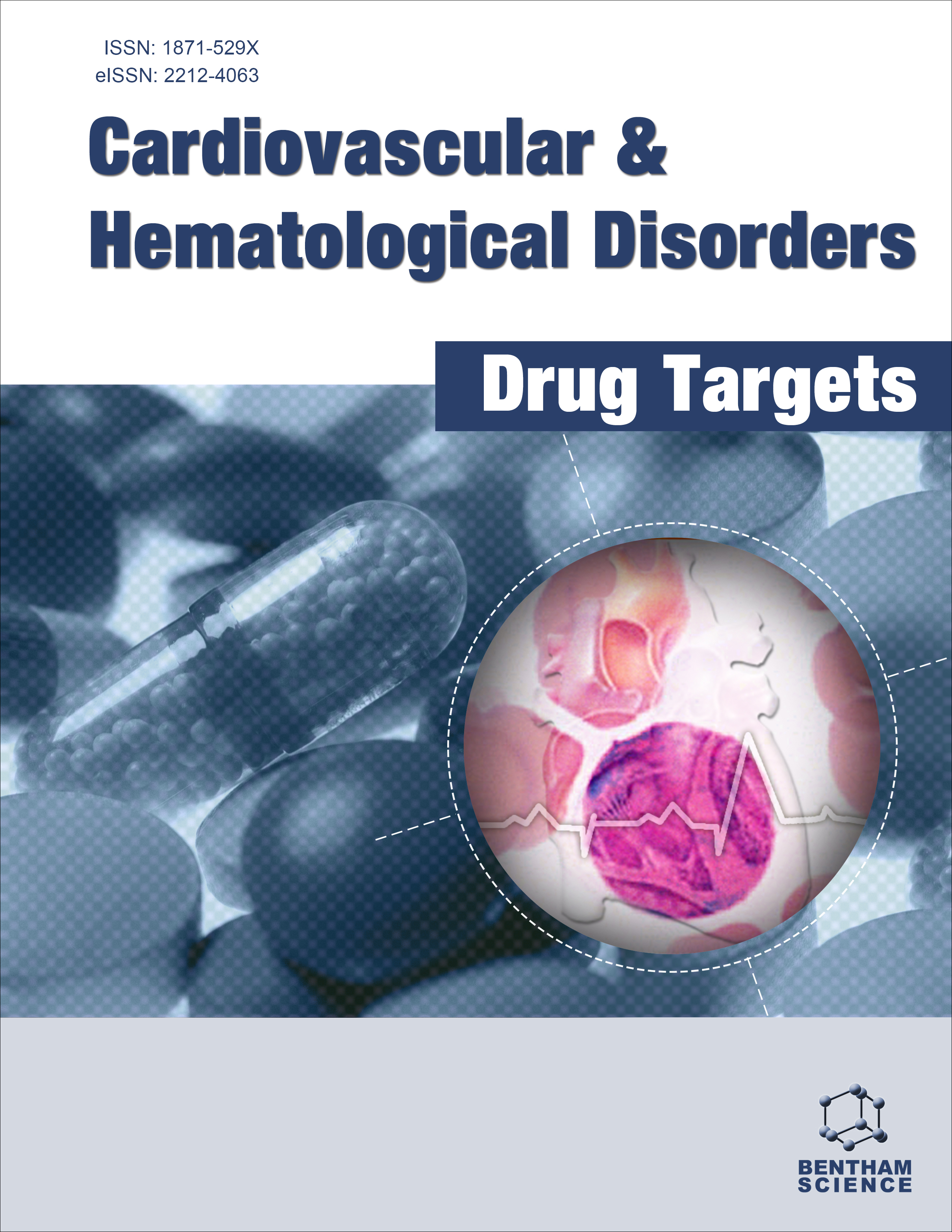- Home
- A-Z Publications
- Cardiovascular & Haematological Disorders - Drug Targets
- Previous Issues
- Volume 10, Issue 1, 2010
Cardiovascular & Haematological Disorders - Drug Targets - Volume 10, Issue 1, 2010
Volume 10, Issue 1, 2010
-
-
A Case of Ischemic Stroke in Acute Promyelocytic Leukemia at Initial Presentation: Relevance of All-Trans Retinoic Acid Treatment
More LessAcute promyelocytic leukemia (APL) is frequently associated, often from the earliest phases, with a lifethreatening coagulation/bleeding syndrome; disseminated intravascular coagulation (DIC) is described in majority of patients. We report a case of 49-year-old male, without cardiovascular risk factors, who suddenly developed ischemic stroke and splenic infarction as presenting symptoms of APL and related DIC. The patient was Read More
-
-
-
Cardiovascular Disease: What's All the AGE/RAGE About?
More LessAuthors: Drazenka P. Barlovic, Merlin C. Thomas and Karin Jandeleit-DahmAdvanced glycation end-products (AGEs) are involved in mediating the effects of hyperglycaemia in diabetes. The most important receptor for AGEs is the receptor for advanced glycation end-products (RAGE). Binding of AGEs to RAGE converts transient cellular stimulation into sustained cellular dysfunction driven by long-term activation of the proinflammatory transcription factor NF-kB. Different splice variants of RAGE e Read More
-
-
-
Pharmacologic Targeting of Endothelial Progenitor Cells
More LessAuthors: Mattia Albiero, Lisa Menegazzo, Angelo Avogaro and Gian P. FadiniThe endothelium entered the field of regenerative medicine with the discovery of endothelial progenitor cells (EPCs). These cells participate in endothelial homeostasis and are actively involved in physiological and pathological neovascularization. Despite the unresolved discussion about the very phenotype of these cells, great efforts have been devoted to study the role of EPCs in cardiovascular diseases. EPCs are very rare i Read More
-
-
-
Risk Factors and Mediators of the Vascular Dysfunction Associated with Hypertension in Pregnancy
More LessAuthors: Stephanie J. Sheppard and Raouf A. KhalilNormal pregnancy is associated with significant hemodynamic changes and vasodilation in the uterine and systemic circulation in order to meet the metabolic demands of the mother and developing fetus. Hypertension in pregnancy (HTN-Preg) and preeclampsia (PE) are major complications and life-threatening conditions to both the mother and fetus. PE is precipitated by various genetic, dietary and environmental factors. Althou Read More
-
-
-
A Review on the Risk of Myocardial Infarction Associated with the NSAID Diclofenac
More LessAuthors: Florian Krotz and Lena StruthmannThe popular over-the counter analgesic drug diclofenac has recently been associated with increased rates of myocardial infarction among patients with cardiovascular risk as well as among healthy populations. Although other traditional non-steroidal anti-inflammatory drugs (tNSAID) have also been accused to exert this risk, literature data at present gives reason to believe that the hazard of myocardial infarction is mainly asso Read More
-
-
-
Clopidogrel-Proton Pump Inhibitor Interaction: A Primer for Clinicians
More LessAuthors: Christopher Allen, Steven P. Dunn, Tracy E. Macaulay and Debabrata MukherjeeThe European Medicines Agency (EMEA) recently issued a public statement on a possible interaction between clopidogrel and proton pump inhibitors (PPIs) and recommended that the product information for all medicines containing clopidogrel be amended to discourage concomitant use of PPIs unless absolutely necessary. This follows a prior alert issued by the United States Food and Drug Administration (FDA) earlier Read More
-
-
-
Amiodarone - A ‘Broad Spectrum’ Antiarrhythmic Drug
More LessAmiodarone, an iodinated benzofuran derivative, introduced in 1960's as an anti-anginal agent, emerged as a potent anti-arrhythmic agent by 1970's and is currently one of the most commonly prescribed drugs in US for ventricular and atrial arrhythmias. Although amiodarone is considered a class III anti-arrhythmic agent, it also has class I, II, IV actions, making it a unique and effective anti-arrhythmic agent. Because of its Read More
-
Volumes & issues
-
Volume 24 (2024)
-
Volume 23 (2023)
-
Volume 22 (2022)
-
Volume 21 (2021)
-
Volume 20 (2020)
-
Volume 19 (2019)
-
Volume 18 (2018)
-
Volume 17 (2017)
-
Volume 16 (2016)
-
Volume 15 (2015)
-
Volume 14 (2014)
-
Volume 13 (2013)
-
Volume 12 (2012)
-
Volume 11 (2011)
-
Volume 10 (2010)
-
Volume 9 (2009)
-
Volume 8 (2008)
-
Volume 7 (2007)
-
Volume 6 (2006)
Most Read This Month
Article
content/journals/chddt
Journal
10
5
false
en


